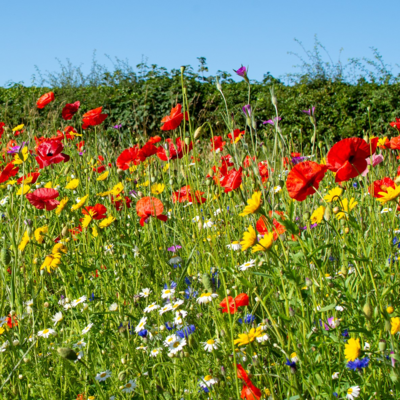Search results for "cowslip"

Plants for Pollinators highlights plants selected by the RHS as scientifically proven to tackle the declines in bees, butterflies and other pollinators.
Cowslip plants form clusters of bell-shaped, sunny yellow flowers with distinct tubed calyxes. Known for having a sweet and strong scent compared to apricots, and it has a history in folklore, with uses in weddings and other festivities. An easy-to-grow Easter-time treat!
- Type: Perennial
- Height: 15–30cm.
- Flowers: April-May
- Soil Requirement: Moist but well-drained
- Light Requirement: Full sun or partial shade
- Natural Habitat: Meadows, woodlands, road verges
- Also known as: Fairy Cup, Key Flower, Luck Flower, Paggles

Plants for Pollinators highlights plants selected by the RHS as scientifically proven to tackle the declines in bees, butterflies and other pollinators.
A perennial wildflower with an aromatic presence. Cowslip displays a rosette of green, tongue-like leaves upon a green stem. The flowers are deep yellow with orange markings in the center, similar to an egg yolk.
- Type: Perennial
- Height: 10-30cm
- Flowers: April-May
- Best Sown: Autumn or Spring
- Soil Requirement: Well-drained
- Light Requirement: Full sun and partial shade
- Natural Habitat: Meadows, grassland, woodland edges, verges
- Also known as Cowslip Primrose, Oxlip
- Seeds per gram: 1100

Plants for Pollinators highlights plants selected by the RHS as scientifically proven to tackle the declines in bees, butterflies and other pollinators.
Use the BSXP 100% wildflower seed mixture to create a diverse and colourful wildflower meadow. Contains bold annual species for impact after sowing, as well perennials to provide longevity.
- Contains 28 beautiful wildflower species - corncockle, poppy, selfheal, cowslip, yellow rattle.
- First year colour from 30% of bold cornfield annuals.
- Perennials begin flowering in the second year.
- Developed on our own research and development site.
- Contains native wildflowers produced from provenance-assured, wild UK meadow collections.
- Sow at 3 grams per sq/m - 1kg covers 330sq/m
- Mixture contents and information (Image taken July, sown in March)

Plants for Pollinators highlights plants selected by the RHS as scientifically proven to tackle the declines in bees, butterflies and other pollinators.
Wildflower seeds for shade. Use this shade wildflower mix to establish wildflowers in areas of semi or partial shade. This includes hedgerows, woodland edges and areas in sunlight for only part of the day.
- Contains twenty two British native wildflower species, including Cowslip, Foxglove, Dark Mullein and Common St John's-Wort.
- Species in this mixture are frequently found in hedgerows, woodland edges, clearings and open woods. Can also be sown in partial shade; hedge bottoms, tree plantations and woodland rides.
- Contains native wildflowers produced from provenance-assured, wild UK meadow collections.
- Sow at 3 grams per sqm - 1kg sows 330 sq/m
- Click this link for mixture contents and information.

Plants for Pollinators highlights plants selected by the RHS as scientifically proven to tackle the declines in bees, butterflies and other pollinators.
Use this mixture to establish wildflowers and grasses in areas of partial and semi shade, such as hedgerows or other areas in sunlight for only part of the day.
- Contains twenty two British native wildflower species, including Cowslip, Foxglove, Dark Mullein and Common St John's-Wort.
- Species in this mixture are frequently found in hedgerows, woodland edges, clearings and open woods. Can also be sown in partial shade; hedge bottoms, tree plantations and woodland rides.
- Contains native wildflowers produced from provenance-assured, wild UK meadow collections.
- Sow at 5 grams per sqm - 1kg sows 200 sq/m
- Click this link for mixture contents and information.


Plants for Pollinators highlights plants selected by the RHS as scientifically proven to tackle the declines in bees, butterflies and other pollinators.
Use this mixture to create a lower growing area of grass and wildflowers, ideal for flowering lawns or where important not to inhibit visibility.
- Contains a blend of twenty low growing wildflower species, including Forget Me Not, Yellow Rattle, Cowslip, Bladder Campion and Ragged Robin.
- Formulated to contain only lower growing species, ideal for areas where it is important not to restrict visibility such as alongside roads.
- Contains native wildflowers produced from provenance-assured, wild UK meadow collections.
- Sow at 5 grams per sqm - 1kg sows 200 sq/m
- Click this link for mixture contents and information.

Plants for Pollinators highlights plants selected by the RHS as scientifically proven to tackle the declines in bees, butterflies and other pollinators.
Use this mixture to create a permanent wildflower meadow of mostly low growing species. Ideal for flowering lawns or road verges.
- Contains a blend of twenty low growing wildflower species, including Forget Me Not, Yellow Rattle, Cowslip, Bladder Campion and Ragged Robin.
- Formulated to contain only lower growing species, ideal for areas where it is important not to restrict visibility such as alongside roads.
- Contains native wildflowers produced from provenance-assured, wild UK meadow collections.
- Sow at 3 grams per sqm - 1kg sows 330 sq/m
- Click this link for mixture contents and information.




